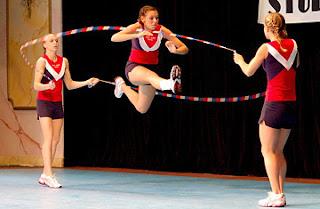Lab Seven: Jumping Rope for a Healthy Heart
1. Can a child in a wheelchair enter the front door and back door? What modifications would you make? Yes the child can participate in the activity. Some modifications that can be made are making sure the jump rope swingers are going at a slower pace in order to have the student get through the front door. When attempting the back door the student can try to roll over the rope with his wheelchair.
2. How would you apply goal setting to this lesson? At the beginning of the class we can all set a personal goal of jump roping however many times they think is possible. Through each progression remind the students that the set that goal and if it needs to be adjusted higher or lower to do that. We could also wear pedometers if accessible and make a class goal of how many steps will we get in class today will practicing jump roping.
3. Design a long rope jumping routine for a pair of students jumping at the same time. The students can play a game where one student jumps in to jump rope while the partner counts how many times they get. Once they miss a jump the other partner gets a chance to jump and see how many jumps they can get.
4. Create a checklist of critical elements to look for and use in teaching basic, two foot rope jumping. Make sure student is swinging with wrist, not whole arm. Make sure student if jumping with both feet at the same time and landing at the same time. Make sure the feet are not coming off the ground more than a few inches. Make sure the rope is being fully extended while swinging.
5. Describe how you would go about organizing a rope jumping club for your elementary school. Wherever the club will be held I will put up posters of advanced skills students may try. I will have a large variety of jump ropes for the different types of students. There will be a pre-assessment for the me to see where each student is in order to put them into correct groups according to ability. Each child will create their own jump roping routine with music and demonstrate at the end of the club.
6. Explain what stimulus variation is and give an example from today's lab when it was used. Stimulus variation is a way of enhancing children learning by helping them remain attentive. It is a way of maintaining students ' attention. Positive results of learners who given a task in a more interesting lesson can perform well and there will be no disciplinary problems. In lab today you taught with stimulus variation by keeping us moving and switching different activities fast. We used different themes like shadows, shapes, letters, snakes, front and back door. Each activity was very different which held our attention, but they progressed in a low to high level keeping us challenged.



No comments:
Post a Comment